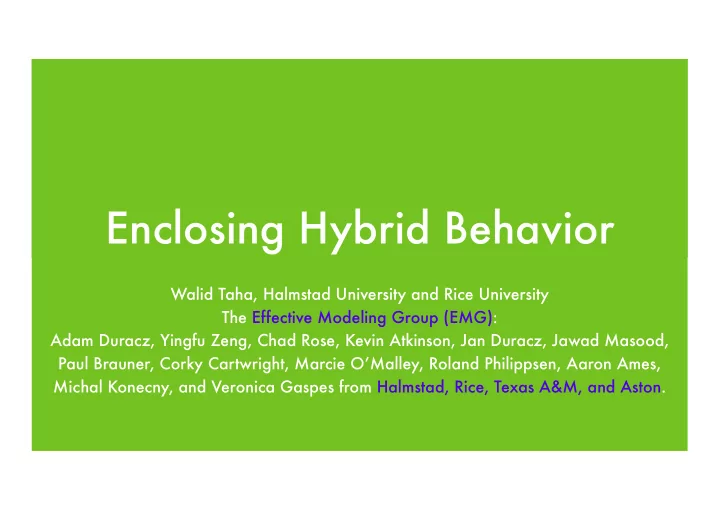

Acumen A Cyber-Physical (CPS) Enclosing Hybrid Behavior Modeling Language Walid Taha, Halmstad University and Rice University The Effective Modeling Group (EMG): Adam Duracz, Yingfu Zeng, Chad Rose, Kevin Atkinson, Jan Duracz, Jawad Masood, Paul Brauner, Corky Cartwright, Marcie O’Malley, Roland Philippsen, Aaron Ames, Michal Konecny, and Veronica Gaspes from Halmstad, Rice, Texas A&M, and Aston.
cps-vo.org
What is innovation? Idea Requirements Model Societal welfare Prototype Product
Innovation theory Idea Requirements Bug Model Societal welfare Flaw Prototype Disaster Product
Virtual testing Virtual testing Idea Verification Virtual testing = S + T + V Test Bug Model Simulate Societal welfare Flaw Prototype Disaster Product
Robot design ! !
Simulation tools today • No guarantee that behavior computed is consistent with model used. • Numerical artifacts • Integration drift • Singularities often ignored • Zeno behavior
Rest of this talk • Enclosure methods • Enclosing continuous behaviors • Enclosing hybrid systems • Event detection and reset maps • Zeno behavior • Conclusions
Idea: Enclosure methods • Always guarantee that solution is enclosed • Can compute more precise answers as needed • But can they be mechanized?
Continuous behaviors • An elegant, very general method exists: • Picard iteration • Key challenge: Extending to proper enclosures
Example
Example
Event detection • Enclosures provide a natural method for event detection (root find) • Basic idea: • Mean value theorem • It’s OK to say “I don’t know”
Reset maps • Assume worst case behavior • Note: Still need to know it was only *one* event that occurred in that interval
Example
Example Text
A bouncing ball
Zeno Behavior • A real problem for rigid body dynamics with impacts • A bouncing ball comes to rest in finite time, but it does so with an infinite number of bounce events!
Enclosing Zeno • Idea: We can actually relax that requirement if we know that a repeat event does NOT enlarge the enclosure we start with
Enclosing Zeno, Take I t x dx/dt t x
Fix: Over-constraining • Enforce domain constraints (intersect) • Example: x >= 0 • Constraining speed based on explicit energy • Example: A notion of energy
Enclosing Zeno, Take II x t dx/dt t
Enclosing Zeno, Take III E t x t dx/dt t
Empire State Building
Technical results • Proper interval Picard converges • Event detection is sound • Zeno method is sound
Next Generation Testing
Uncertainty-aware design
Activity in NG-Test • Analysis of ISO 26262-3 • Defining high-level models of test scenarios • Vehicles, controls, sensors • Using enclosures to establish bounds on severity of collisions • Gradual model refinement is key
Conclusions • Using enclosures • ensures that any answer produced is correct • simplifies correct event detection • admits an elegant way of handling certain classes of Zeno behavior • benefits from over-constraining
Future work • Understanding algorithmic complexity • Understanding performance on larger models (mainly drawn from the robotics domain) • Identifying heuristics to limit loss of precision during continuous segments
Thank you! • Checkout acumen-language.org
Recommend
More recommend